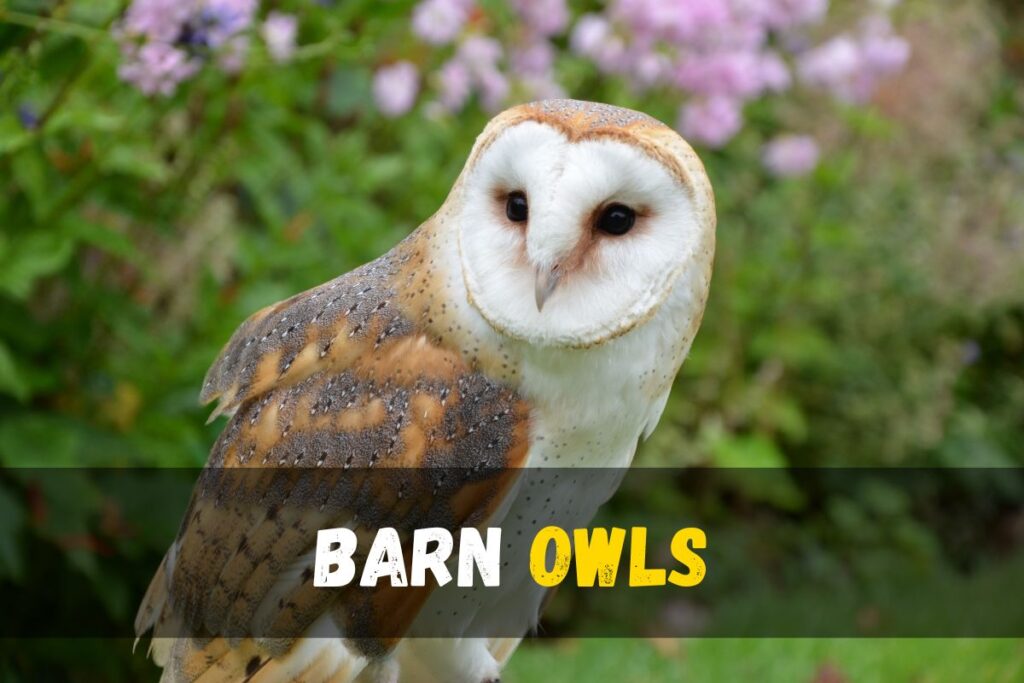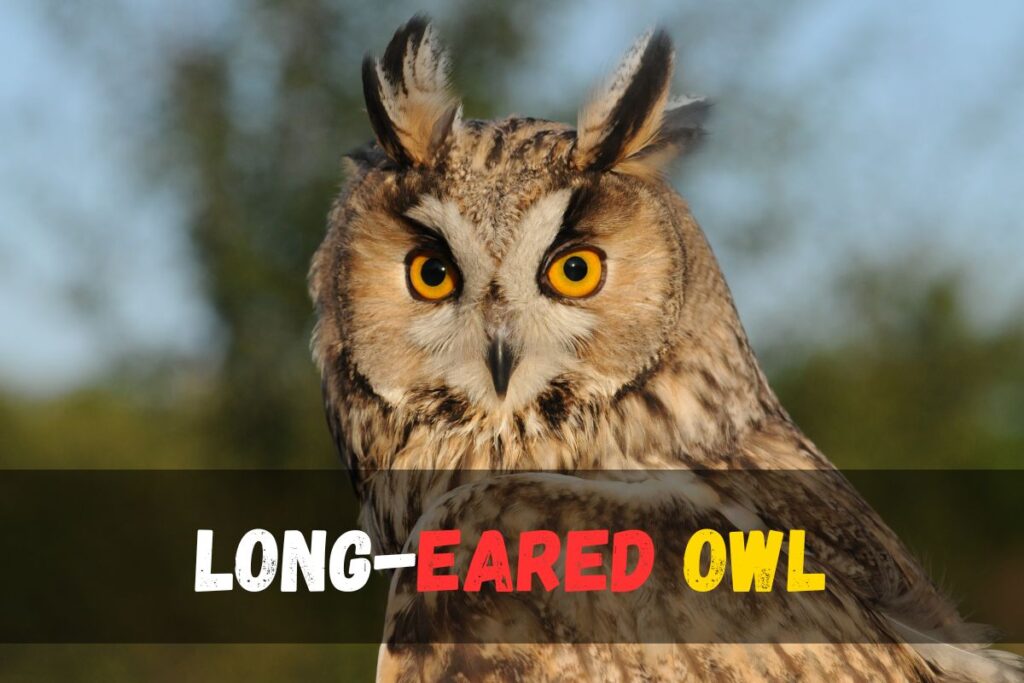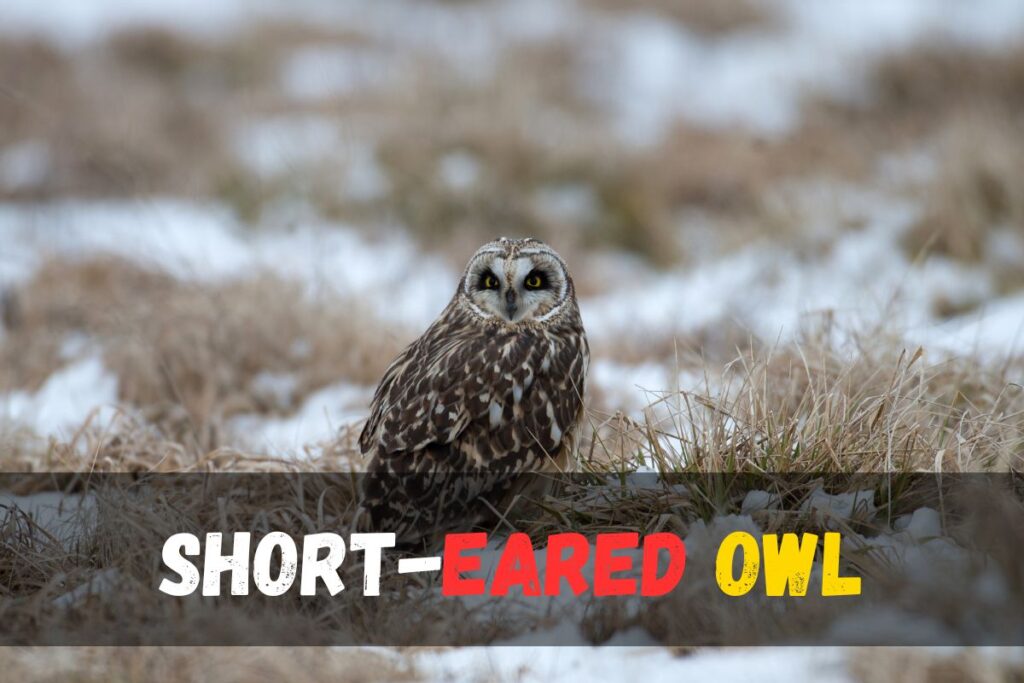11 Types of Owls in Michigan
Great Horned Owl
The Great Horned Owl, scientifically known as Bubo virginianus, is a majestic raptor also affectionately dubbed the “tiger owl” owing to its striking appearance. Recognized for its impressive tufts, this owl boasts plumage that varies from mottled greyish-brown on its upper body to a paler shade underneath, adorned with distinctive brown barring. Its facial disc, either reddish-brown or grey, contrasts with a white throat patch, lending it an unmistakable visage. With an impressive wingspan ranging from 3 to 5 feet and a length spanning between 17 to 25 inches, these owls command attention wherever they’re spotted.

Habitat and Range:
They are highly adaptable and can be found throughout North America, including parts of Central and South America. Within Michigan, they establish residence year-round, favoring a diverse array of habitats. These include wooded areas for nesting and roosting, as well as open landscapes for hunting. Whether perched amidst woodland edges, orchards, farmlands, or even in suburban areas, these owls thrive in environments that offer a mix of shelter and prey.
16 Types of Owls in Texas
Behavior:
The Great Horned Owl exhibits a range of vocalizations, from hoots to screeches, creating an eerie ambiance. As apex predators, they’re known for their prowess in hunting, capable of taking down prey larger than themselves, including other birds of prey. Nocturnal hunters by nature, also display occasional daytime activity, making them a captivating sight for bird enthusiasts.
Unique Characteristics and Identification:
One of the most distinguishing features of the Great Horned Owl is its “horns,” which are tufts of feathers atop its head, used for camouflage. These, coupled with its large yellow eyes outlined in black and robust hooked bills, make it easily identifiable. Its plumage, varying from region to region, aids in its concealment within its surroundings, enhancing its predatory advantage.
Where to Find Them:
To observe Great Horned Owls in Michigan, one should explore woodland and forest edges, orchards, farmlands, and quiet suburban locales. They’re often spotted perched in larger nesting boxes or pilfering nests of other birds. During winter, their presence is especially notable, with a significant percentage recorded in winter checklists submitted by birdwatchers.
Diet:
As formidable hunters, Great Horned Owls have a diverse diet encompassing over 200 species of mammals and approximately 300 bird species. Their prey includes rodents, rabbits, mice, voles, and hares, as well as various amphibians, reptiles, and invertebrates. They’re also known to tackle larger prey such as ospreys and falcons, showcasing their formidable predatory skills.
Barn Owl
8 Types of Owls in Virginia
Description:
The Barn Owl (Tyto alba), distinguished by its heart-shaped face and pale, speckled plumage, is a medium-sized owl species. With a wingspan ranging from 31 to 49.2 inches and a length of 12.6 to 15.8 inches, it exhibits a unique blend of grace and elegance. Its appearance often likened to that of a ghostly figure, makes it an unmistakable sight among Michigan’s owl population.

Habitat and Range:
Their nesting preferences vary from barns and old buildings to tree holes, crevices along cliffs, and even nest boxes. While they’re widespread globally, they are considered rare in Michigan due to factors like habitat loss and severe winters.
Behavior:
Being strictly nocturnal creatures, They are most active during the night. They exhibit an undulating flight pattern, often gliding low above the ground while hunting for prey. Their exceptional hearing and vision in dim light enable them to precisely locate and capture prey. Despite their nocturnal habits, they may occasionally be spotted during the day flying between roosting sites.
Unique Characteristics and Identification:
The Barn Owl’s distinctive features include its heart-shaped facial disk, contrasting dark eyes, and predominantly white underparts with varying speckling patterns. Their upperparts exhibit rusty-brown hues with dark patches, adding to their unique appearance. Their silent flight, coupled with their eerie screech rather than a typical owl hoot, further sets them apart from other owl species.
Where to Find Them:
In Michigan, They are more commonly sighted in the southern regions, particularly near Detroit and in areas with open countryside. Despite their rarity, diligent observers may still catch a glimpse of these elusive birds, especially during nocturnal hunting excursions.
Diet:
They primarily feed on small mammals like voles, rodents, and occasionally insects, lizards, amphibians, bats, and birds. After capturing their prey, they swallow it whole and later regurgitate indigestible parts like bones and fur in the form of pellets.
Long-Eared Owl
Description
The Long-eared Owl (Asio otus) is a medium-sized owl known for its distinct ear tufts, which give it a unique appearance. This owl species has a dark, mottled plumage of brown, grey, and buff tones. Its facial disc is light buff with a white center, complemented by striking orange-yellow eyes and a greyish-black bill. Long-eared Owls measure between 14 to 16 inches in length, with a wingspan ranging from 35 to 39 inches.

Behavior
These owls are primarily nocturnal, remaining elusive during the day and becoming active at night. Long-eared Owls are skilled hunters, preying mainly on small mammals such as voles, mice, young rats, and rabbits. They are known for flying low over the ground, using their excellent hearing to detect movements of potential prey.
Unique Characteristics and Identification
The Long-eared Owl can be distinguished by its slender body, prominent ear tufts, and distinctive facial disc. It bears a resemblance to the Great Horned Owl but is notably smaller and features ear tufts that are closer together. Their plumage varies in darkness depending on the region, with eastern individuals generally darker than those in the west.
Where to Find Them
To locate Long-eared Owls in Michigan, explore wooded areas with thick foliage, particularly those with a mix of coniferous and deciduous trees. These birds often roost at the tops of trees, camouflaging themselves well against potential predators. Listening for their unique calls, which resemble a slow, steady ‘whoo’ during the breeding season, can aid in their detection.
Diet
Long-eared Owls primarily feed on small mammals like voles, mice, rats, and rabbits. They may also consume small birds occasionally. Their hunting strategy involves flying silently just above ground level, relying on keen hearing to detect and capture prey.
Short-Eared Owl
Description
The Short-eared Owl (Asio flammeus) is a medium-sized owl known for its distinctive appearance. It features a rounded head with barely visible ear tufts, a mottled brown, buff, and white plumage, and a pale facial disk rimmed with brown. Its eyes are strikingly yellow, encircled by dark patches, giving it a piercing look.

Behavior
Unlike most owls, Short-eared Owls are diurnal and crepuscular, meaning they are active during twilight and daylight hours. They hunt primarily during dawn and dusk when their prey, such as voles and mice, are most active. They have a distinctive flight pattern, described as floppy and bat-like.
Unique Characteristics and Identification
The Short-eared Owl’s key identifying features include its short ear tufts, often hard to discern, and its preference for open habitats. Its call is a raspy bark and is relatively quiet outside of the breeding season. This owl is adept at flying low over the ground, using keen eyesight and hearing to locate prey.
Where to Find Them
In Michigan, Short-eared Owls can be spotted mainly in open fields and grasslands, particularly during winter in the southern regions. During the breeding season, they are more likely to be seen in the northern half of the state. Look for them flying low over these open areas or perched on the ground.
Diet
Short-eared Owls primarily feed on rodents such as voles, rats, and mice. They are also known to prey on small birds, including gulls and shorebirds. Interestingly, they remove the wings of birds before consuming them. Their hunting behavior is tailored to target active species during daylight hours, aligning with their diurnal habits.
Northern Saw-Whet Owl
Description
The Northern Saw-whet Owl (Aegolius acadicus) is one of the smallest owl species in North America, measuring between 7 to 9 inches in size with a wingspan of 17 to 22 inches. They have a distinctive appearance characterized by a large, round head, compact body, and bright yellow eyes. Their plumage is rich brown with white spots on the upperparts and white streaks below. Notably, they have a white Y-shaped pattern between their eyes.

Behavior
These owls are strictly nocturnal, meaning they are active at night. They have exceptional hearing and can locate prey by sound alone. Northern Saw-whet Owls are adept at hiding, often perching at eye-level near tree trunks or concealed among thick foliage during the day. They are relatively common but challenging to spot due to their small size and camouflage.
Unique Characteristics and Identification
Apart from their small size, Northern Saw-whet Owls are recognized by their distinctive facial features, including the large round head, bright yellow eyes, and the white Y-shaped pattern on their face. Juveniles have plain brown heads with visible white eyebrows and cinnamon-brown underparts.
Where to Find Them
In Michigan, Northern Saw-whet Owls can be observed year-round, but they are more prevalent in the northern parts of the state. Look for them in dense coniferous forests, mixed woodlands, and areas near open spaces and water sources where they hunt for prey.
Diet
These owls predominantly feed on rodents, such as mice and voles, which make up the majority of their diet. They also consume small birds, bats, amphibians, and insects. Despite their diminutive size, they share a similar diet to larger owl species, preying on smaller creatures within their habitat.
Barred Owl
Description
The Barred Owl (Strix varia) is a large owl species found in Michigan, characterized by its drab, barred plumage. Its upper body is brown with cream-white barring, while its underside showcases a scalloped mantle and brown streaks on the lower breast and belly. This owl features a prominent, rounded head with a pale facial disk and large, dark eyes set close together. Its bill is pale yellow, and it has feathered legs and distinctive yellow feet with black talons.

Behavior
These owls are sedentary by nature, meaning they do not migrate across different climate seasons. They are vocal raptors known for their wide repertoire of calls, including a series of eight hoots described as “hu hu hu hoo.” Barred owls hunt opportunistically after sunset, typically from a perch, targeting small mammals, birds, amphibians, reptiles, fish, and invertebrates.
Unique Characteristics and Identification
The Barred Owl is easily identifiable by its distinctive hooting call, often described as sounding like “Who cooks for you all?” They have excellent camouflage against trees due to their barred plumage and are skilled hunters with keen eyesight, targeting prey with precision from high up in the trees.
Where to Find Them
Barred owls are commonly found throughout Michigan, especially in mature forests and woodlands. They often stay in pairs and are more active during their spring mating season.
Diet
The primary diet of barred owls consists of small mammals, but they are opportunistic predators and will also prey on birds, amphibians, reptiles, fish, and invertebrates. They use their sharp talons and beaks to capture and consume their prey, demonstrating remarkable hunting abilities.
Eastern Screech Owl
Description
The Eastern Screech Owl (Megascops asio) is a small, stocky raptor with broad wings and a short tail. It exhibits varied plumage, ranging from gray to rusty brown, with distinct ear tufts atop its large head. This owl measures between 6.5 to 10 inches in size, with a wingspan of 18 to 24 inches, and typically weighs 4 to 8 ounces. Its appearance aids in camouflage against tree bark, where it often roosts during the day.
Behavior
Primarily nocturnal hunters, Eastern Screech Owls are skilled predators that feed on small animals like birds, mammals, insects, reptiles, and amphibians. They hunt from perches, using their keen vision and silent flight to capture prey. Their calls range from whinnying to tremolo sounds, often heard during nighttime hours or at dawn and dusk.
Unique Characteristics and Identification
The Eastern Screech Owl is distinguished by its mottled coloring and prominent ear-tufts resembling “horns.” It comes in three color morphs: gray, red (rufous), and brown. The gray morph offers exceptional camouflage against tree bark, making them challenging to spot. Their small size, large head, and compact build differentiate them from other owl species.
Where to Find Them
In Michigan, Eastern Screech Owls can be located in wooded areas near water bodies, suburban neighborhoods, parks, and gardens. Look for them in tree cavities, nest boxes, or perched in dense foliage close to tree trunks during the day. Their presence can be indicated by pellets and the excited calls of mobbing songbirds.
Diet
They are opportunistic feeders, preying on a variety of creatures depending on the season. During breeding, they consume insects, spiders, and invertebrates, while in winter, they target small birds and mammals like mice and voles. This adaptability allows them to thrive even in developed areas, showcasing their resilience and flexibility in habitat and diet.
Snowy Owl
Description
The Snowy Owl (Bubo scandiacus) is a majestic owl known for its striking appearance. It has a predominantly snowy-white plumage with dark spots, especially on the upperparts. The females are more heavily marked with brown barring. These owls have large bodies, reaching lengths of up to 27.9 inches (71 cm), and can weigh between 56.4 to 104.1 ounces (1600-2950 g). Their most distinctive features are their bright yellow eyes and lack of ear tufts, which sets them apart from other owl species.

Behavior
Unlike many other owl species, Snowy Owls are diurnal, meaning they are active during the day. They rely heavily on their keen eyesight for hunting, perching, or flying low to the ground to catch small mammals like lemmings, voles, and other rodents. Snowy Owls are birds known for their nomadic behavior and unpredictable migration patterns.
Unique Characteristics and Identification
Snowy Owls are easily identifiable by their size, snowy-white plumage, and striking yellow eyes. Male snowy owls are mostly white, while females retain dark barring on their feathers even into adulthood. They lack ear tufts and have rounded heads. Snowy Owls also have a far-carrying barking call instead of the typical owl hooting.
Where to Find Them
In Michigan, Snowy Owls are primarily spotted during their winter migration from December to February. They can be found in various habitats including open fields, grasslands, airport fields, and coastal areas. Snowy Owls tend to perch on elevated sites like hummocks or ridges, providing them with a vantage point to observe their surroundings.
Diet
The preferred diet of Snowy Owls consists of small mammals like lemmings, voles, and rodents. They are known to consume a significant number of lemmings annually, helping to regulate rodent populations in their habitats. Additionally, Snowy Owls may also prey on birds, fish, amphibians, and insects when other food sources are scarce.
Great Gray Owl
Description
The Great Gray Owl (Strix nebulosa) is a striking owl known for its large size and distinctive appearance. It boasts a silvery-gray plumage with subtle streaks of brown and white, complemented by a sizable rounded head adorned with a gray face and striking yellow eyes encircled by dark rings. Despite its imposing size, much of its bulk is due to its dense, fluffy feathers rather than body mass.
Behavior
Great Gray Owls are nocturnal hunters, relying heavily on their exceptional hearing to locate prey. They perch and patiently wait for the opportune moment to swoop down and capture small mammals and birds. Interestingly, they are known for plunging into the snow to seize prey hidden beneath the surface, showcasing their adaptive hunting techniques.
Unique Characteristics and Identification
What sets the Great Gray Owl apart is its large facial disk, which aids in sound localization and prey detection even in thick snow cover. Despite its impressive size, it lacks ear tufts, distinguishing it from other owl species. Additionally, a distinctive white collar under the bill adds to its unique appearance.
Where to Find Them
In Michigan, sightings of Great Gray Owls are rare but most likely during winter months, particularly in the northern part of the state. They inhabit remote, densely wooded areas where they can hunt effectively. Patient observation in suitable habitats can reward bird enthusiasts with glimpses of these majestic creatures.
Diet
Great Gray Owls are formidable predators, preying on a variety of animals including weasels, ducks, hares, and rodents like moles and mice. They are also known to hunt small birds such as grouse, mountain quail, and Canada jays. Mated pairs often collaborate during the breeding season, with the male primarily responsible for hunting and provisioning food for the family.
Northern Hawk-Owl
Description
The Northern Hawk-Owl (Surnia ulula) is a distinctive medium-sized owl, measuring between 14.5 to 17.5 inches in length with a wingspan of around 33 inches. It has a brown plumage with cream-white spots on its upperparts and a cream-white underside with brown barring. Its face is gray with a dark border, complemented by striking yellow eyes and a bill.

Behavior
Unlike most owls, the Northern Hawk-Owl is diurnal, meaning it is active during daylight hours. This behavior, along with its hunting style, which involves scanning for prey from perches in open areas, often makes it noticeable to bird watchers. Although not migratory, they may occasionally move southward during winter, especially in response to food availability.
Unique Characteristics and Identification
Northern Hawk Owls can be easily identified by their unique appearance. They have white faces outlined by thick black lines, yellow eyes, and a v-shaped forehead that gives them a distinctive expression. Their long tails and brown wings with white spots further contribute to their recognizable features.
Where to Find Them
In Michigan, Northern Hawk-Owls are rare but can sometimes be spotted in the northern parts of the state, particularly in open areas like forest clearings, valleys, meadows, and wooded farmlands. Their presence in Michigan is notable because it lies within the southern extent of their range.
Diet
During the summer, Northern Hawk Owls primarily feed on mammals such as voles. In winter, they shift their diet to include ground-dwelling birds like ptarmigan and grouse. They are efficient hunters, using their keen eyesight to locate prey from perches and occasionally employing unique hunting techniques such as snow-plunging to catch prey below the surface, relying on sound detection.
Boreal Owl
Description
The Boreal Owl (Aegolius funereus) is a small and elusive owl species, measuring between 8.7 to 10.6 inches in size and weighing around 3.3 to 7.6 ounces. It has a distinctive appearance with brown plumage adorned with white flecks on the upper parts and white with brown streaks underneath. This owl is characterized by its large head, grayish-white facial disk, and striking yellow eyes.
Habitat and Range
Boreal Owls primarily inhabit dense coniferous forests, particularly those found in the northern parts of North America including Canada and the northwestern United States. They prefer forests with spruce, aspen, poplar, birch, and fir trees, where they can nest and roost.
Behavior
These owls are primarily nocturnal hunters but can also be active during daylight hours in regions with shorter nights. They are skilled ambush predators, perching high in trees and swooping down swiftly to capture prey such as rodents, small birds, and insects. Boreal Owls are solitary and elusive birds, often challenging to spot due to their secretive nature and nocturnal habits.
Unique Characteristics and Identification
One of the distinctive features of the Boreal Owl is its broad, flat head with bright yellow eyes. Unlike some other owl species, Boreal Owls lack prominent ear tufts. Their facial disks are light gray with a brown border, adding to their unique appearance. Juveniles differ from adults, lacking the white spots on the crown and back and having a more uniform chocolate-brown coloration.
Where to Find Them
In Michigan, Boreal Owls are rarely spotted but can occasionally be seen in the northern parts of the state, particularly during winter. They prefer areas with dense forest cover, making the boreal forests of Michigan a suitable habitat for these owls.
Diet
The diet of Boreal Owls consists mainly of small mammals such as rodents, supplemented with small birds and insects. They rely on their exceptional hunting skills, utilizing their sharp talons and acute vision to capture prey efficiently. These owls are adapted to hunting from perches, scanning the surroundings for movement before striking swiftly.
FAQ’S
What is the most common owl in Michigan?
In Michigan, the Great Horned Owl, Barred Owl, and Eastern Screech Owl reign as the most prevalent owl species. However, to determine the absolute most common owl in Michigan, further data analysis or research specifically focused on owl population densities in Michigan would be required.
Are owls protected in Michigan?
Yes, owls are protected in Michigan under state law (MCL 324.41301). Without the appropriate permits or licenses, it is against the law to possess, capture, or take any wild bird, including owls, from their natural habitat. This indicates that owls are safeguarded by regulations that prohibit their removal or disturbance without authorization.
Do owls nest in Michigan?
Yes, owls, specifically Great horned owls, do nest in Michigan. They are one of the largest owl species found in the region. Their preferred nesting habitats include open fields with small wood lots nearby, which are prevalent throughout much of Michigan. Therefore, Michigan’s landscape and habitat characteristics make it conducive for Great horned owls to nest there.
What is the little owl in Michigan?
The little owl commonly found in Michigan is the Northern saw-whet owl. This small yet formidable nighttime hunter is often heard during calm winter nights, particularly in conifer forests across the U.S.
Are owls rare in Michigan?
There are 11 species of owls. Some of these owl species are found quite frequently throughout the year, while others are rare visitors. Therefore, while certain types of owls are commonly spotted, others are indeed considered rare in Michigan. So, the presence and frequency of owls in Michigan vary depending on the specific species.
Do owls live in Michigan in the winter?
yes, owls do indeed live in Michigan during the winter months. Particularly the Eastern Upper Peninsula is noted as one of the prime regions for observing rare winter owls. Therefore, if you are interested in seeing owls during the winter, It is a recommended destination along with northern Wisconsin.
What is the tallest owl in Michigan?
The tallest owl in Michigan is the Great Gray Owl. Although they are pretty rare in Michigan, these owls are occasional winter visitors to the Upper Peninsula, where they can be found in trees at the edges of meadows.


